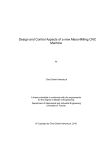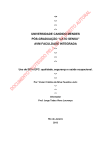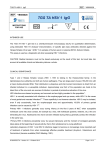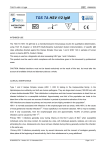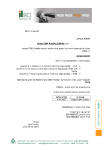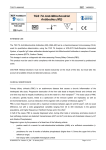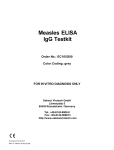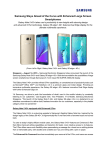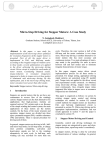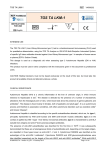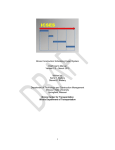Download TGS TA Rubella IgG Avidity
Transcript
TGS TA Rubella IgG Avidity REF REF YB500047 YB500047 TGS TA Rubella IgG Avidity INSTRUCTIONS FOR USE 50 EN English 0459 INTENDED USE The TGS TA Rubella IgG Avidity test is a chemiluminescent immunoassay (CLIA) for determination, using TGS TA Analyser or IDS-iSYS Multi-Discipline Automated System, of Avidity Index of specific IgG class antibodies directed against Rubella virus in samples of human serum or plasma (EDTA, Sodium Citrate). The possibility of differentiating antibodies at high avidity from low avidity allows to supply interesting clinical information. This assay is used as a diagnostic aid when assessing immunity status of patients related to Rubella virus infection. This product must be used in strict compliance with the instructions given in this document by professional users. CAUTION: Medical decisions must not be based exclusively on the result of this test, but must take into account all available clinical and laboratory data as a whole. CLINICAL SIGNIFICANCE Rubella is a mild exanthematous and moderately contagious disease caused by Rubella virus, which is the sole member of the Rubivirus genus of the Togavirus family. The only known hosts for Rubella virus are 1 humans and only one serotype has been identified . Rubella is commonly called German measles or 3-day 2 measles and it is the third of the six exanthemas of chilhood . The disease is transmitted human to human, via airborne droplet emission from the upper respiratory tract of active patients. The incubation is about 2 to 3 weeks. This disease is often mild and many patients are asymptomatic. The primary symptoms are : appearance of a rash on the face which spreads to the trunk and limbs and usually fades after three days, low grade fever, 3 swollen glands, joint pains ,headache and conjunctivitis . The severe syndromes happen when pregnant women are infected with Rubella virus, especially if the infection happens in the first trimester of the pregnancy. The infection can be transmitted to the fetus through placenta, and the so called congenital Rubella syndrome ( CRS ) may occur, which lead to miscarriage, prematurity or stillbirth. If the fetus survives the CRS, serious defects may occur, including blindness, deafness, or life threatening organ disorders 3,4 . Although rare in many industrialized countries, because of the success of vaccination programs, Rubella continues to occur where uptake of the vaccine is slow and in many developing countries with no vaccination IFU051TGS TA – Version: 01_EN – 2 October 2014 Page 1 of 13 TGS TA Rubella IgG Avidity REF YB500047 program. The World Health Organization (WHO) has therefore encouraged all countries to assess their 5 Rubella immunostatus and introduce immunization and surveillance, if appropriate . Clinical diagnosis of Rubella is unreliable, as Rubella virus infection can be asymptomatic in up to 50% of infected patients . Furthermore the rash caused by Rubella virus and the accompanying symptoms are so similar to other viral infections that it is impossible for a physician to make a confirmed diagnosis on visual examination alone. Thus ,serological tests are needed for a diagnosis, especially when a patient is 6 pregnant . Rubella antibody testing are so the main diagnostic tool available to either establish a previous exposure to Rubella or Rubella vaccination or a current infection/re-infection with Rubella. 7 A primary acute Rubella infection is associated with an elevated IgM antibody response to the Rubella virus ; Rubella virus specific IgM are detectable after the incubation period and usually disappear after 8 approximately 8 weeks , although in rare cases they may be present a year or more after natural infection or vaccination and after asymptomatic reinfection 9,10 . Rubella virus specific IgGs appear immediately after IgMs 8 11 and they show a greater-than-fourfold rise in their titer and persist for life . In addition to IgM and IgG determinations immunoglobulin G avidity testing has been shown to be useful for 12 differentiating recent from past Rubella infection , investigating suspected Rubella in pregnant women 13 and 14 congenital Rubella syndrome . PRINCIPLE OF THE METHOD The TGS TA Rubella IgG Avidity kit for determination of the avidity index of specific anti-Rubella IgG employs an indirect two-step immunological method based on the principle of chemiluminescence. The test can be done only by using samples previously tested to detect the presence of IgG anti Rubella. The specific antigen is used to coat the magnetic particles (solid phase) and an anti-human IgG antibody is labelled with an acridinium ester derivative (conjugate). Each specimen is dispensed into two adjoining cuvettes: cuvette (a) as reference and (b) in which a buffer able to prevalently break the binding Antigen (Ag)- Antibody (Ab) if the antibody is at low avidity, is added . During initial incubation, the specific antibodies present in the sample, in the calibrators or in the controls bond with the solid phase. In the second cuvette (b) only, at the end of the first incubation, a second incubation is performed in a buffer able to break the binding between the Ag of the magnetic particles and the Antibodies IgG of the samples if they are present at low avidity. During the last incubation, the conjugate reacts with the anti-Rubella IgG antibodies captured by the solid phase. After each incubation, the material that has not bound with the solid phase is removed by aspiration and subsequent washing. The quantity of labelled conjugate that remains bound to the solid phase is assessed by activation of the chemiluminescence reaction and measurement of the light signal. The generated signal, expressed in relative light units (RLU), is indicative of the concentration of specific antibodies present in the sample, in the calibrators and in the controls. The ratio between the concentration of antibodies of the second cuvette (b) (treated sample- IgG not removed) and the concentration of antibodies of the first cuvette (a) ( not treated sample-Total IgG) is the Index of Avidity of the Antibodies IgG Anti Rubella present in the sample. IFU051TGS TA – Version: 01_EN – 2 October 2014 Page 2 of 13 TGS TA Rubella IgG Avidity REF YB500047 AUTOMATION The TGS TA Analyser instrument automatically performs all the operations envisaged by the assay protocol: addition of samples, calibrators, controls, magnetic particles, conjugates and chemiluminescence activation solutions to the reaction cuvette; magnetic separation and washing of particles; measurement of the emitted light. The system calculates the assay results for the samples and controls by means of a stored calibration curve and prints a report that includes all the information related to the assay and to the patient. MATERIALS AND REAGENTS Materials and reagents supplied REAG 1 MP 2.5 mL Magnetic particles coated with inactivated Rubella antigen (strain HPV 77) in Phosphate Buffer containing stabilising proteins, Pro-Clin 300 and sodium azide (< 0.1%) as preservatives. REAG 2 CONJ 25 mL Mouse Monoclonal anti-human IgG antibody labelled with an acridinium ester derivative (conjugate), in Phosphate Buffer containing stabilising proteins, surfactant and sodium azide (< 0.1%) as preservative. REAG 3 DIL 25 mL Sample Diluent Solution: Phosphate Buffer containing bovine serum albumin, a surfactant, an inert blue colouring agent, Pro-Clin 300 and Gentamicin SO4 as preservatives. REAG 4 BUF AV 15 mL AV Buffer Solution: Borate Buffer containing a dissociating agent and sodium azide (< 0.1%) as preservative. REAG 5 CAL A 1.6 mL Human serum with low Avidity of anti-Rubella IgG antibodies in Phosphate Buffer containing bovine serum albumin, a surfactant, an inert blue colouring agent, Pro-Clin 300 and Gentamicin SO4 as preservatives. REAG 6 CAL B 1.6 mL Human serum with high Avidity of anti-Rubella IgG antibodies in Phosphate Buffer containing bovine serum albumin, a surfactant, an inert blue colouring agent, Pro-Clin 300 and Gentamicin SO4 as preservatives. IFU051TGS TA – Version: 01_EN – 2 October 2014 Page 3 of 13 TGS TA Rubella IgG Avidity REF YB500047 All reagents are ready for use. Reagents 1, 2, 3 and 4 are assembled in a single reagents cartridge unit. The Calibrator concentrations are expressed in IU/mL (International Units) and calibrated against WHO 1st IS RUBI-1-94, 1996. The concentration settings, specific for each production lot, are recorded on the DATA DISK included in the kit. DATA DISK A Mini-CD containing data regarding all the products in the TGS TA line (Reagents, Calibrators, Control Sera) updated to the last production lot with the exclusion of products that have expired at the date when the new DATA DISK was compiled. Only the DATA DISK with the highest lot number needs to be kept to maintain the information required for correct operation of the system up to date. Materials and reagents required but not supplied in the kit: (1) - TGS TA Analyzer 120 - IDS-iSYS Cuvette Cube Cod. No. TGS00001 (1) Code No. IS-CC1000 (2) Code No. IS-CS1000 Pack of 960 cuvettes - IDS-iSYS System Liquid 1 bottle containing 5 liters of ready-to-use solution. - IDS-iSYS Wash Solution (2) Code No. IS-CW1000 1 bottle containing 10 liters of ready-to-use solution. - IDS-iSYS Trigger Set (2) Code No. IS-CT1000 1 250 mL-bottle of Trigger A (pre-trigger solution) 1 250 mL-bottle of Trigger B (trigger solution) - TGS TA D-SORB Solution Code No. YC500009 Pack of 2 bottles containing 1 liter of ready-to-use solution. - IDS-iSYS Cartridge Checking System - TGS TA ImmunoCleaner (2) Code No. IS-601000 Code No. YC500012 6 bottles each containing 27 mL - TGS TA Top Cap Set Code No. YC500010 300 red top caps to close the calibrator containers after first use. IFU051TGS TA – Version: 01_EN – 2 October 2014 Page 4 of 13 TGS TA Rubella IgG Avidity (1) REF YB500047 manufactured by IDS France SAS, 42 rue Stéphane Mazeau, 21320 Pouilly en Auxois, France and distributed by Technogenetics Srl. (2) manufactured by da IDS SA, 101-103 rue Ernest Solvay, 4000 Liège, Belgique and distributed by Technogenetics Srl. Other Recommended Reagents TGS TA Rubella Avidity Control Set Cod. No. YB500048 Three 1.0 mL vials of Low-moderate Avidity serum and three 1.0 mL vials of High Avidity of IgG anti-Rubella antibodies. WARNINGS AND PRECAUTIONS The reagents supplied in the TGS TA Rubella IgG Avidity kit are only for in vitro diagnostic use and not for in vivo use in humans or animals. This product must be used in strict compliance with the instructions given in this document by professional users. Technogenetics cannot be held responsible for any losses or damages caused by use not in conformity with the instructions supplied. Safety precautions This product contains material of animal origin and therefore must be handled as if it contains infecting agents. This product contains components of human origin. All units of serum or plasma used to produce the reagents in this kit have been analysed with FDA-approved methods and found not to be reactive due to presence of HBsAg, anti-HCV, anti-HIV1 and anti-HIV2. However, since no analysis method is able to guarantee the absence of pathogenic agents, all material of human origin must be considered to be potentially infected and handled as such. In the event of damaged packaging or accidental leakage, decontaminate the area concerned with a diluted solution of sodium hypochlorite after putting on suitable personal protective equipment (overall, gloves, goggles). Dispose of the material use for the clean-up and of the packaging involved in the leakage according to national regulations for disposal of potentially infected waste. In the event of damaged packaging or accidental leakage, do not use the reagents to perform the assay. Some reagents contain sodium azide as a preservative. Since sodium azide may react with lead, copper and leaded brass forming explosive azides in piping, it is recommended that reagents or waste are not poured down drains but are disposed of in compliance with the national regulations on disposal of potentially hazardous waste. IFU051TGS TA – Version: 01_EN – 2 October 2014 Page 5 of 13 TGS TA Rubella IgG Avidity REF YB500047 Operating precautions Reliable results can only be obtained by strictly complying with these instructions and carefully following what is written in the operating manual for the instrument. The reagents supplied in the kit must be used only with the TGS TA Analyzer system. The components of the reagent cartridge must not be removed from the cartridge and reassembled. Do not use the kit after its expiry date. REAGENT PREPARATION The reagents supplied in the kit are all ready for use. REAGENT STORAGE AND STABILITY Store the reagents supplied in the kit at 2-8°C in a vertical position in a dark place. In these conditions, unopened reagent cartridge and calibrators are stable until the expiry date. After opening, the reagent cartridge can be used for 60 days if kept in a refrigerator at 2-8°C or in the analyser. After opening, the calibrators can be used for 60 days if kept in a refrigerator at 2-8°C and if they have not been left in the analyser for more than 6 hours per session. Do not freeze the reagents and calibrators. SAMPLE PREPARATION AND STORAGE The assay must be performed on samples of human serum and plasma (EDTA – Sodium Citrate). Use of lipaemic, haemolysed and turbid samples is not recommended. If the assay is performed after more than 8 hours, separate the serum or the plasma from the clot, from the red blood cells and transfer the supernatant from the gel separating tubes to the secondary tubes. Before being analysed, samples may be kept in a refrigerator at 2-8°C for a maximum of 7 days. If the assay is to be performed after more than 7 days, store the samples frozen (< -20°C). Avoid repeated freezing and thawing. OPERATING PROCEDURE Carefully follow the instructions given in the user manual of the instrument to obtain reliable analytical results. Loading of reagents All the reagents supplied in the kit are ready for use. Before inserting the reagent cartridge in the system, the magnetic particle container must be horizontally agitated by rotation in order to ensure correct resuspension of the particles. Avoid generating foam when performing this operation. Place the reagent cartridge in the reagent area of the instrument using the rack provided and leave it to be agitated for at 1 hour before use. IFU051TGS TA – Version: 01_EN – 2 October 2014 Page 6 of 13 TGS TA Rubella IgG Avidity REF YB500047 Positioning of the reagent cartridge simultaneously determines reading of the identification bar-code. If the cartridge label is damaged or if it is not readable, the reagent cartridge identification data can be entered manually. The instrument automatically maintains the magnetic particles constantly agitated. If the reagent cartridge is removed from the instrument, store it at 2-8°C in a vertical position in a dark place. Loading of calibrators TGS TA calibrators are ready for use. Leave the calibrators at room temperature for 10 minutes and then gently shake the contents, either manually or using a vortex, avoiding the formation of foam. When using the calibrators for the first time, remove the guarantee seal and the white sealing cap before placing them in the analyser. If the calibrators have already been used, the container will have a top cap (red cap) with no guarantee seal. Remove the red closing cap before placing them in the analyser. Place the calibrators in the samples area of the analyser; see the analyser user manual on how to identify them in the analyser. Bar-code data must be entered manually if the label is damaged or if it is unreadable. The IgG anti-Rubella antibody concentration in the calibrators are recorded in the DATA DISK and automatically transferred to the analyser. At the end of the session, the calibrator containers must be closed with the top caps (red caps) provided and stored at 2-8°C until they are used again. The calibrators can be used for a maximum of four times. Loading of controls Place the controls in the samples area of the analyser. See the analyser user manual on how to identify them in the analyser. If there is no bar-code on the control or if it is not readable, the control identification data must be entered manually. If TGS TA Controls are used, see the instructions for use provided. The Avidity Index of IgG anti-Rubella antibody in the TGS TA controls are recorded in the DATA DISK and automatically transferred to the analyser. Select the required parameters for each control. Loading of samples Place the samples in the samples area of the analyser; see the analyser user manual on how to identify them in the analyser. If there is no bar-code on the sample or if it is not readable, the sample identification data must be entered manually. Select the required parameters for each sample. According to the concentration of Rubella IgG previously tested, 2 protocols are available. They can be selected in “analyte list” parameters according to the following scheme: Rubella IgG concentration between 10 and 300 IU/mL Rubella Avidity IgG 10-300 Rubella IgG concentration > 300 IU/mL Rubella Avidity IgG>300 IFU051TGS TA – Version: 01_EN – 2 October 2014 Page 7 of 13 TGS TA Rubella IgG Avidity REF YB500047 Calibration The TGS TA Analyzer instrument uses a memorised calibration curve (master curve), generated by the manufacturer for each lot of reagent cartridges. The “master curve” parameters, together with the calibrator concentration settings, are stored in the DATA DISK and transferred to the instrument’s database. Calibrators A and B are used to recalibrate the “master curve” in both for the instrument used and for the reagents on board. To recalibrate, analyse three replicates of the two calibrators (A and B) and one replicate of each control. The concentration obtained with the controls make it possible to validate the new calibration. Once recalibration of the “master curve” has been accepted and stored in memory, all subsequent samples can be analysed without any further calibration, except in the following cases: - when a reagent cartridge with a new lot number is loaded into the instrument; - when the controls do not fall within the range of acceptability; - after instrument maintenance; - when the validity of the recalibrated “master curve” has expired. The validity of the recalibrated “master curve” for the TGS TA Rubella IgG Avidity kit is 21 days. Recalibration management is handled automatically by the analyser. Assay Press the start button. 1. The system aspirates 100 µL of Sample Diluent, 20 µL of Magnetic Particles, 100 µL of Sample Diluent and 10 µL of sample or control (for the calibrators the positive serum is supplied prediluted with Sample Diluent and the volume aspirated is 110 µL). The aspirated solutions and suspension are dispensed into the reaction cuvette. 2. The reaction cuvette is incubated in the rotor at 37°C for 10 minutes. 3. After this phase of incubation, the magnetic particles are separated and washed. a) Only in the second sample cuvette (b) 200 µL of Buffer Avidity are added and the cuvette is incubated in the rotor at 37°C for 10 minutes. b) After this phase of incubation, the magnetic particles are separated and washed. 4. 200 µL of conjugate are dispensed into the cuvette. 5. The reaction cuvette is incubated in the rotor at 37°C for 10 minutes. 6. After this last phase of incubation, the magnetic particles are separated and washed and the cuvette is transferred to the reading chamber. 7. The quantity of conjugate bonded to the solid phase, expressed in RLU, is directly proportional to the concentration of anti-Rubella IgG present in the sample. 8. The readings obtained are interpolated on the calibration curve and transformed into concentrations and Avidity Index. IFU051TGS TA – Version: 01_EN – 2 October 2014 Page 8 of 13 TGS TA Rubella IgG Avidity REF YB500047 QUALITY CONTROL To ensure the validity of the assay, control sera at differing levels of avidity (at least one low-moderate avidity serum and one high avidity serum) must be measured every day in which dosage is performed. If individual laboratory practice so dictates, more frequent or more numerous controls may be performed for verification of assay results. Follow local quality control procedures. If TGS TA control sera are used, the expected average concentration and the acceptability limits are those given on the DATA DISK included in the control set pack too. If different control sera are used, before using them, the values expected with TGS TA reagents and system must be defined. If the control values does not fall within the specified range of acceptability, the related assay results are not valid and the respective samples must be analysed again. In this case, before repeating the tests, a recalibration procedure must be performed. CALCULATION AND INTERPRETATION OF THE RESULTS Calculation of the results The concentration of the anti-Rubella IgG present in the samples that are being tested is automatically calculated by the system. The results can be viewed on the display or printed. The concentrations are expressed in IU/mL. Calculation of the analyte concentration in the sample takes place by interpolating the response obtained for each sample on a calibration curve calculated in accordance with a 4-parameter logistic fitting (4PL, Y weighted), periodically corrected according to the responses obtained for calibrators assay results. For detailed information on how the system calculates the results, please see the analyser user manual. The measurement range of TGS TA Rubella IgG is: 0.0 – 468 IU/mL. Values lower than 0.0 IU/mL are extrapolated values, the message “OMR-” and/or ORA appears and they are shown as “equal to 0.0 IU/mL”. Values higher than 468 IU/mL are accompanied by the message “OMR+” and/or ORA and may retested after suitable dilution. The Avidity elaborated by the instrument is expressed in Index. The results of the samples may be interpreted in the following way: (Index) Interpretation < 0.20 The sample should be considered at Low Avidity IgG anti-Rubella 0.20-0.25 The sample should be considered at Moderate Avidity IgG anti-Rubella > 0.25 The sample should be considered at High Avidity IgG anti-Rubella IFU051TGS TA – Version: 01_EN – 2 October 2014 Page 9 of 13 TGS TA Rubella IgG Avidity REF YB500047 The values reported above are indicative only. Each laboratory will establish its own reference intervals. LIMITS TO THE ASSAY METHOD For diagnostic purposes, the results obtained with the TGS TA Rubella IgG Avidity kit and the TGS TA Analyser system must be used together with the other clinical and laboratory data available to the physician. Bacterial contamination of the sample and heat inactivation may influence the result of the dosage. Heterophilic antibodies present in human serum samples may react with immunoglobulin-based reagents, causing interference with in vitro immunological dosages. Such samples may give rise to anomalous readings if analysed with the TGS TA Rubella IgG Avidity kit. DIAGNOSTIC SPECIFICITY AND SENSITIVITY By the use of TGS TA Rubella IgG, TGS TA Rubella IgM and TGS TA Rubella IgG Avidity kits it is possible to evaluate the patient immune status related to Rubella infection. In the following table are reported the serological profiles of the 3 tests Rubella IgG, Rubella IgM and Rubella IgG Avidity and their relative interpretation with respect to the virus exposure: IgG anti- IgM anti- IgG anti-Rubella Avidity Rubella Rubella (2nd level test) negative negative -- negative positive -- positive positive Low Avidity Interpretation Not-Immune - Individual susceptible to infection Suspected acute primary infection Recent primary infection (last 2 months from sample collection) Recent, previous infection with positive positive High Avidity persistent IgM presence (more than last 2 months from sample collection) positive negative High Avidity- Past infection Using the TGS TA Rubella IgG, TGS TA Rubella IgM, TGS TA Rubella IgG Avidity tests, the diagnostic specificity and sensitivity were assessed in the following population of selected samples, examined with different methods and classified according to the rule of general consensus: 98 not-immune patients 95 samples from patients infected by Rubella of which, 14 follow-up samples coming from 2 patients in seroconversion and 4 patients with primary infection, 5 samples from as many patients with primary infection within 1 month, 2 samples with not dated primary infection and 74 samples from as many patients with not recent infection IFU051TGS TA – Version: 01_EN – 2 October 2014 Page 10 of 13 TGS TA Rubella IgG Avidity REF YB500047 Following the interpretation given above, it was possible to work out the diagnostic specificity and sensitivity relating to each group under evaluation. Of 98 not-immune patients, 97 had IgG values below cut-off by using methods TGS TA Rubella IgG. The diagnostic specificity of method for IgG related to non- immune patients was 99.0% (95% Confidence Interval: 93.6-99.9%). For IgM the specificity calculated on 172 samples (98 not-immune samples and 74 previous infection samples) was 99.4% (171/172) (95% Confidence Interval: 96.3-100.0%). Among 95 samples of patients diagnosed as infected by Rubella in seroconversion, monitoring and followup, the method TGS TA Rubella IgG has shown 93 positive samples, so the sensitivity was 97.9% (93/95) (95% Confidence Interval: 96.0%-100.0%). Among 21 samples from patients diagnosed as infected by Rubella in act, the method TGS TA Rubella IgM has shown 20 positive samples and 1 negative sample, so the diagnostic sensitivity was 95.2% (20/21) (95% Confidence Interval: 74.1-99.8%). By using TGS TA Rubella IgG Avidity kit, in 95 samples from patients diagnosed as above, the Avidity index of Rubella IgG in all 14 samples in seroconversion and followed samples with primary infection was low until 2 months from the onset of symptoms, as well as in all 5 samples with infection in the last month and in 2 samples with recent infection (without dating). In all 74 samples with past infection the Avidity index of Rubella IgG was high. PERFORMANCES Caution: the data presented do not represent the operating specifications of the kit, but serve as experimental proof of how the kit works within these specifications in the manner envisaged by the manufacturer. Precision and Reproducibility The precision and the reproducibility of the TGS TA Rubella IgG Avidity kit have been assessed using a protocol based on the guidelines given in Clinical and Laboratory Standards (CLSI) document EP5-A2. The precision was calculated by analysing the results of 20 replicates of three sera (at low and high index of anti-Rubella IgG Avidity) performed with two different lots of reagents in the same test run. The table shows the results obtained with the 3 sera. Sample 1 2 3 Reagents Lot. no. Mean Index SD Index CV % 2 3 2 3 2 3 0.13 0.16 0.64 0.65 0.67 0.65 0.01 0.01 0.04 0.09 0.05 0.07 7.7 6.3 6.3 13.8 7.5 10.8 IFU051TGS TA – Version: 01_EN – 2 October 2014 Page 11 of 13 TGS TA Rubella IgG Avidity REF YB500047 The reproducibility was calculated by analyzing the results of the determination of five sera at low and high avidity of anti-Rubella IgG performed in 17 different sessions, with three lots of reagents. The table shows the results obtained with the 5 sera. Sample Mean Index SD Index CV % 1 0.14 0.01 7.1 2 0.72 0.03 4.2 3 0.68 0.04 5.9 4 0.69 0.05 7.2 5 0.72 0.03 4.2 Analytical Specificity: Interferences A study based on the guidelines given in the CLSI document EP7-A2 has shown that the dosage performances are not influenced by the presence in the sample of the potentially interfering substances listed in the table below, up to the tested concentration. Potentially Interfering Substances Free bilirubin Conjugated bilirubin Haemoglobin Triglycerides Maximum tested concentration 20 20 1000 3000 mg/dL mg/dL mg/dL mg/dL Use of lipaemic, haemolysed and turbid samples is not in any case recommended. Relative Sensitivity and Specificity The avidity index of IgG anti-Rubella antibodies was determined using the TGS TA Rubella IgG Avidity kit and an immunoenzymatic assay available on the market in 77 samples (18 at low avidity and 59 at high avidity). 2 samples gave rise to discordant results between the TGS TA assay and the other available method. The global relative agreement was therefore found to be 97.4 % (95% Confidence Interval: 90.1%– 99.5%) (75/77). The relative agreement in low avidity samples was found to be 88.9% (95% Confidence Interval: 63.9%– 98.1%) (16/18). The 2 discordant samples have shown high avidity. The relative agreement in high avidity samples was found to be 100.0% (95% Confidence Interval: 92.4 – 100.0 %) (59/59). IFU051TGS TA – Version: 01_EN – 2 October 2014 Page 12 of 13 TGS TA Rubella IgG Avidity REF YB500047 BIBLIOGRAPHY 1. DM Horstmann. Rubella in : Evans A.S., ed. Viral infections of humans : epidemiology and control. New York: Plenum Press,1976; 409-427. 2. Askin DF. Intrauterine infections. Neonatal.Netw. 2004; 23(5):23-30. 3. Cooper LZ,Alford Jr.CA. Rubella. In : Remington JS, Klein JO, editors. Infectious Diseases of the Fetus and Newborn infant. Philadelphia,PA : Elsevier Saunders ; 2006 : 893-926. 4. Atreya CD, Mohan KV, Kulkami S. Rubella virus and birth defects : molecular insights into the viral teratogenesis at the cellular level. A. Clin. Mol. Terato. 2004; 70 (7): 431-7. 5. Department of Vaccines and Biologicals, WHO. Report of a meeting on preventing congenital Rubella syndrome : immunization strategies, surveillance needs. Geneva : World Health Organization,2000. 6. Best JM, Banatvala JE. Rubella. In . AJ Zuckerman, JE Banatvala, JR Pattison,eds. Principles and th practice of clinical virology. 4 ed. Chichester : John Wiley,2000: 387-418. 7. Best JM, O’Shea S, Tipples G,Davies N, Al-Khusaiby SM, Krause A, Hesketh LM, Jin L, Enders G. Interpretation of Rubella serology in pregnancy-pitfalls and problems. BMJ. 2002;325 (7356): 147148 8. Banatvala JE and Brown DWG. 2004. Rubella. Lancet 363 : 1127-1139 9. Banatvala JE,Best JM, O’Shea S,Dudgeon JA. Persistence of Rubella antibodies following vaccination : detection of viremia following experimental challenge. Rev. Infect. Dis 1985; 7(suppl 1): S86-90 10. Thomas HIJ, Morgan-Capner P, Roberts A, Hesketh L. Persistent Rubella-specific IgM reactivity in the absence of recent primary Rubella and Rubella reinfection. J. Med. Virol. 1992;36 :188-92. th 11. D.O. White and F.J. Fenner. 1994. Medical Virology 4 ed. Academic Press, San Diego,CA. 12. R. Hamkar, S. Jalivand, T. Mokhtari-Azad, K. Nouri Jelyani, H. Dahi-Far,H. Soleimanjahi and R. Nategh.2005. Assessment of IgM enzyme immunoassay and IgG avidity assay for distinguish between primary and secondary immune response to Rubella vaccine. J. Virol. Methods 130 : 59-65. 13. J. Hoffman and U.G. Liebert. 2005. Significance of avidity and immunoblot analysis for Rubella IgMpositive serum samples in pregnant women. J. Virol. Methods 130: 66-71. 14. V. Herne, K. Hedman and P. Reedik. 1997. Immunoglobulin avidity in the serodiagnosis of congenital Rubella syndrome. Eur. J. Clin. Microbiol. Infect. Dis. 16 : 763-766. TECHNOGENETICS S.r.l. Via Vanvitelli, 4 20129 – Milano – Italy IFU051TGS TA – Version: 01_EN – 2 October 2014 Page 13 of 13













